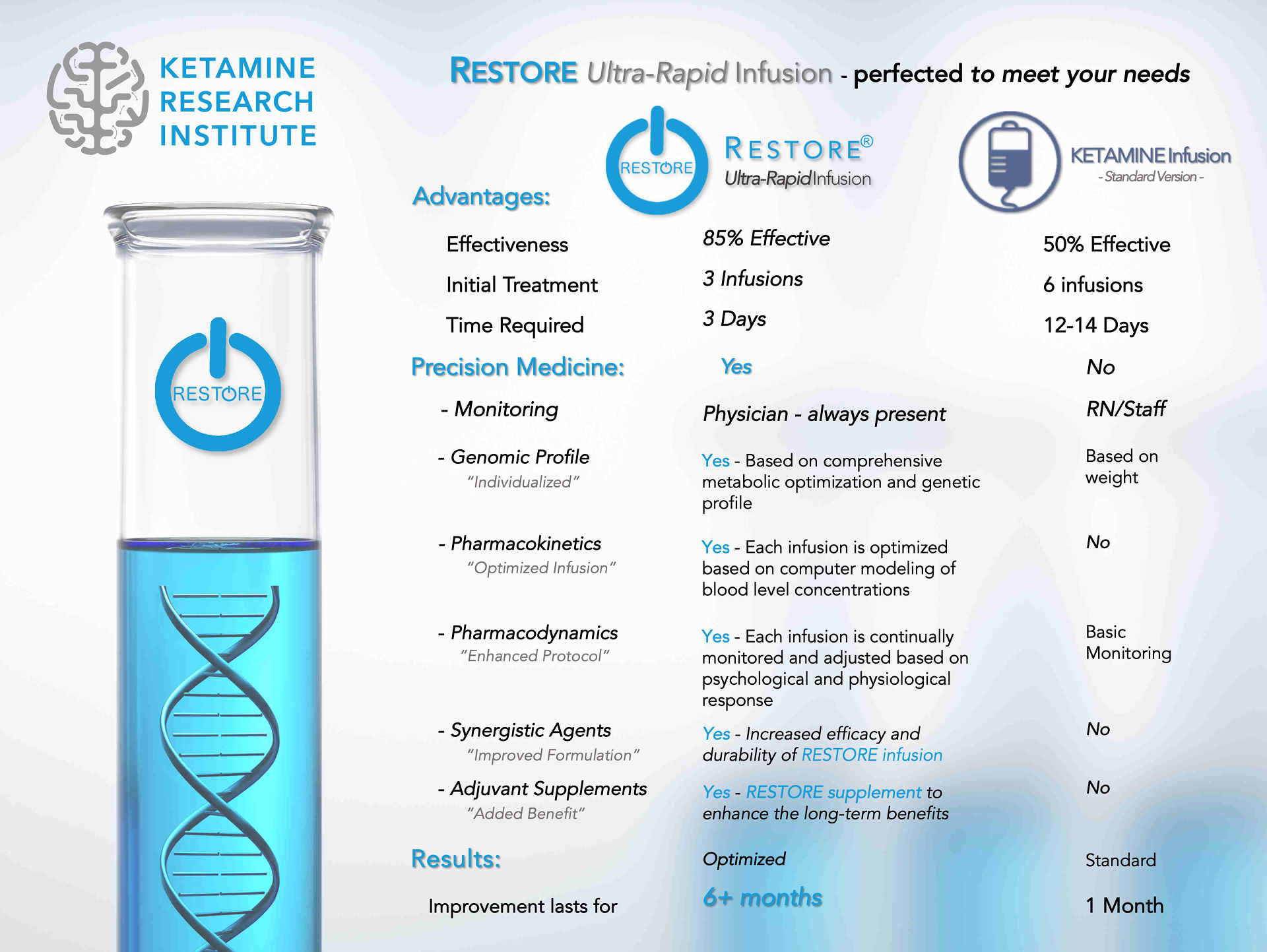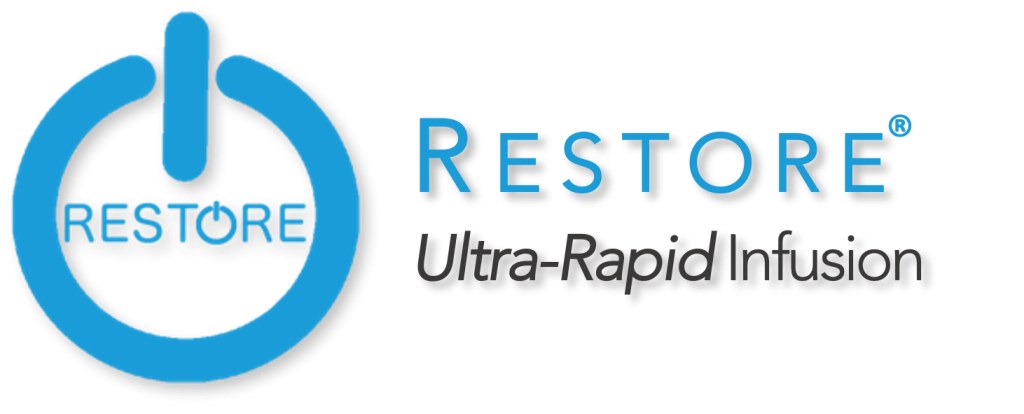Changing the way we approach chronic illness...
RESTORE Advanced Infusion and the RESTORE Essential Infusion

Unlocking the Potential…. Making Ketamine Even More Effective
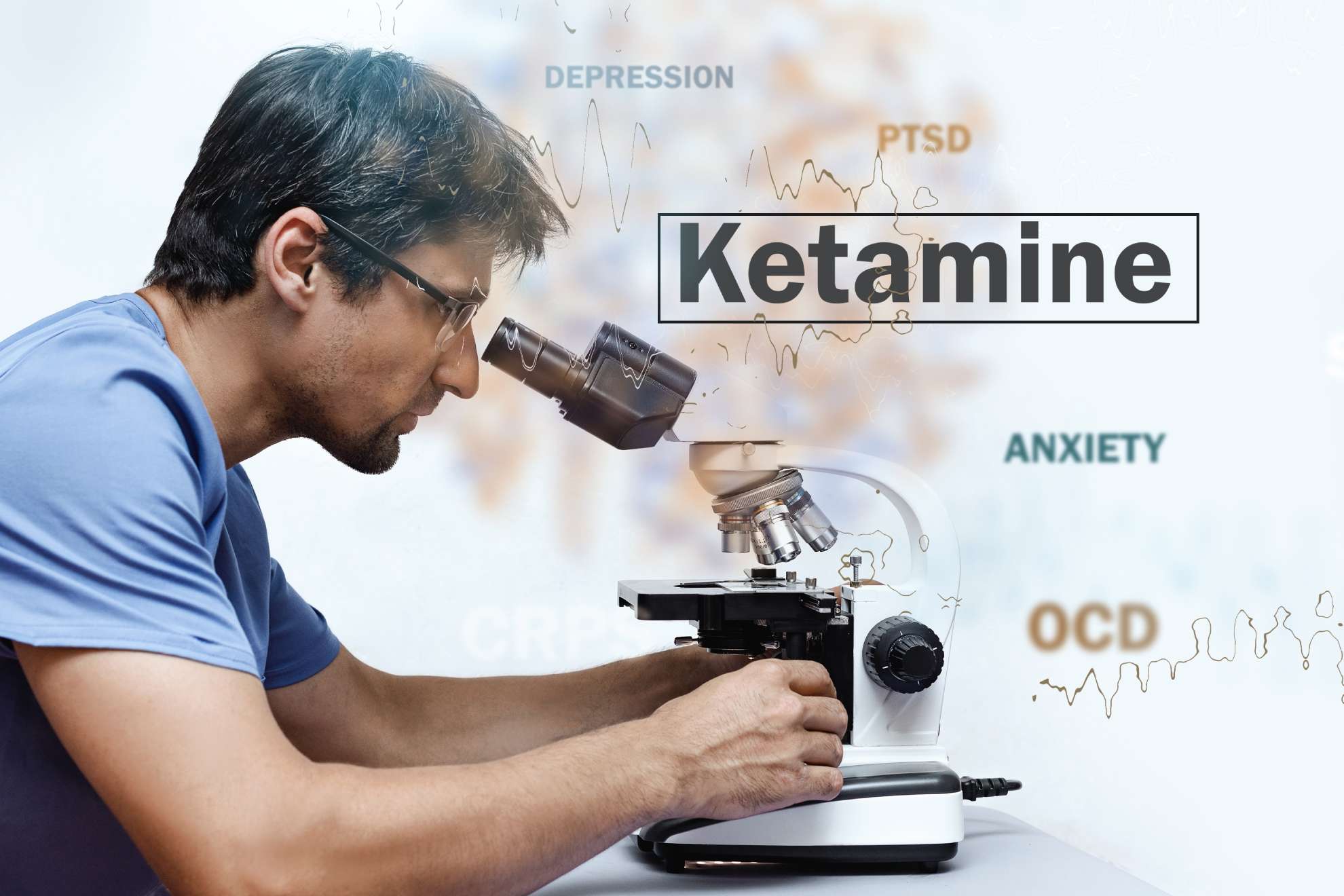
Not all Ketamine Infusions are the same -
RESTORE is the new "Gold Standard" in ketamine infusion therapy.
Just as we all know that no two people are exactly alike, we also know that they will not each respond to medication in the same way. Because of this, it is crucial to select the right treatment for the right person to be maximally effective.
Understanding this, we have used ketamine therapy in many different ways over the years in our search to learn more about what it can do. As a result of our efforts, and after years of clinical use and research, we have developed proprietary ways to increase ketamine's effectiveness and extend the remarkable benefits for months to years.
Compare RESTORE to other Ketamine Infusions
Let's start with the conventional ketamine infusion.

Did you know that only 50% of people may respond to ketamine infusion therapy?
Although ketamine infusion therapy can be remarkably rapid and effective for patients with treatment-resistant depression under research conditions, that is not always the case in actual practice. Research studies report that up to 70% of patients in a clinical research setting improve following ketamine infusion treatment. Unfortunately, while many ketamine clinics will quote that number, far fewer people undergoing ketamine infusion therapy in a ketamine clinic are likely to do as well.
Is a 50/50 chance of improvement really the best that can be expected?
In reality, your chances of experiencing improvement when a ketamine infusion takes place in a local ketamine clinic could be significantly different - and much lower (1). Some believe a more realistic expectation is that only about 40-50% of people respond to ketamine infusions when given in a ketamine clinic setting.
According to one recent report, just 44% of patients with treatment-resistant depression responded favorably after six infusion sessions in a very prestigious community hospital setting (2). In fact, the results can be so variable that in a study published in 2020, conducted at the world-renown Massachusetts General Hospital/Harvard University Department of Psychiatry in Boston, only 15 of 85 (18.3%) of their patients improved following a "standard" ketamine infusion!(3)
There are many reasons for the lower response rate you may experience. Often, this includes a number of factors that can contribute to your success or lack of it. For example, many clinicians providing ketamine therapy lack adequate training or experience administering ketamine, or they may not adhere to appropriate patient selection and treatment standards. Equally as important, they may not appropriately adjust ketamine dosing based on critical factors such as your medications, metabolism, or genetic profile.
Be aware of how time-consuming and expensive ketamine can be.
Regular ketamine infusions, when performed by qualified and experienced clinicians who have strict standards and follow treatment protocols, can unquestionably be effective for many people — they have some significant limitations and drawbacks that you need to be aware of.
The first limitation for some people is that regular ketamine infusion, while helpful in mood disorders such as depression or anxiety, is not very helpful or effective for treating chronic pain. Next, it will require at least six infusions over two weeks to complete the initial treatment series, and you may not know if it's even working until around the third session. As a result, determining whether it is effective for you may take some time.
Ketamine infusion can be very time-consuming.
Many people may find it difficult or impossible to take every other day off from work, school, or their household responsibilities for two weeks to have the therapy. More than that, it is important to remember that you will need someone to drive to and from each of those infusion sessions.
Then, there is the overall expense involved.
When you ask, most local ketamine clinics will tell you the single infusion cost, but that can be misleading and does not reflect the overall costs involved. It is essential to remember that you must multiply the single infusion cost by six or more sessions to finish the initial treatment series.
More than that, if it helps improve your mood and well-being, it may only last for about 4-6 weeks before you need another infusion to help you feel well. So, to maintain the benefit, you will need to continue having infusions every 4-6 weeks after that for an unknown amount of time.
Regular ketamine infusions can become very costly over just the first year – depending upon your location and the clinic; it can amount to over $8,500.00 in many cases.
How does RESTORE compare to a regular ketamine infusion?

Simple...The RESTORE Infusion Therapy® is more convenient, effective, longer-lasting, and costs less than ketamine infusion treatment.
First, RESTORE can be completed in 72 hours (3 days), so you feel better much faster. Second, up to 85% of our clients experience significant improvement - often following the first session! And third, RESTORE lasts much longer for our clients than other infusions - up to 6 times longer than ketamine infusions. This means that you do not need "monthly boosters" as you do with other ketamine infusions. You may only need two maintenance infusions to maintain the benefits for the entire year and, in many cases - obtain complete relief.
Because it works so rapidly, is more effective, and lasts longer than ketamine infusions — the overall expense is much less. Often, less than 1/2 of the cost of regular ketamine therapy over time. Better yet, because of our use of precision medicine and metabolic optimization, combined with an advanced infusion protocol, the RESTORE Infusion can be effective even when standard ketamine infusions, Spravato, or rTMS are not.
Compare RESTORE to Regular Ketamine - Side by Side
How ketamine works:
In basic terms, ketamine blocks a brain receptor known as the NMDA receptor (although it works at many other receptors simultaneously). By blocking specific NMDA receptors, the infusion stimulates a rapid release of the neurotransmitter known as glutamate. Glutamate is an "excitatory" neurotransmitter, and this initial but relatively brief "glutamate burst" quickly helps to lessen symptoms of depression and anxiety for the first few days.
Why typical ketamine infusions only provide short-term relief –
The good news is that if you are suffering from depression and anxiety, you may have a rapid response. Then, to make the ketamine effect last a little longer than just a few days, up to five or more additional infusions are necessary. Now, the bad news: even with six or more repeated ketamine infusions, the beneficial effects are only temporary, usually lasting 3-4 weeks before you need another infusion. So, while the standard ketamine infusion can be very effective initially, clearly, it does not lead to long-term relief or remission of symptoms. Still, if nothing has helped you in the past, and this does, then that is still a great benefit. However, we view this as a "band-aid" approach requiring ongoing monthly infusions to keep feeling better but not providing long-term benefits. Why doesn't it last longer?
Why doesn't regular ketamine last longer?
There are several reasons why the effects of a ketamine infusion do not last very long. It is important to remember that the original ketamine infusion developed at Yale in 1994, which is now commonly used to treat some mood disorders, was never initially intended to treat depression or anxiety.
All medications we use today come in different dosages – different conditions and different individuals respond best to specific amounts of medicine but not others.
Due to ketamine's early reports of success, the original protocol, in which each patient receives 0.5 milligrams of ketamine for each kilogram of overall body weight, was quickly adopted by many without any thought about the "optimal" or best dosage for that person or condition. After all, early reports suggested it worked better than any conventional medication that way, and so it was adopted as "good enough." But is it?
After years of working with hundreds of patients with difficult-to-treat conditions, we have identified many factors that either contribute to an infusion's effects or work against them. Often, these issues are either not discovered or overlooked by many of those providing ketamine-based therapy. For example, many physicians are unaware of the significant effects and interactions of body mass, common medications, and genetic metabolism on the primary and secondary metabolism of ketamine.
Body composition and ketamine:
Ketamine is a very "lipophilic" drug. It naturally tends to quickly and easily accumulate in fatty tissue instead of staying in the blood stream, delivered to the central nervous system. When ketamine is administered based on someone's total body weight and does not consider body composition (amount of body fat), under-dosing or overdosing is more common than most believe. This practice can lead to very different responses between individuals.
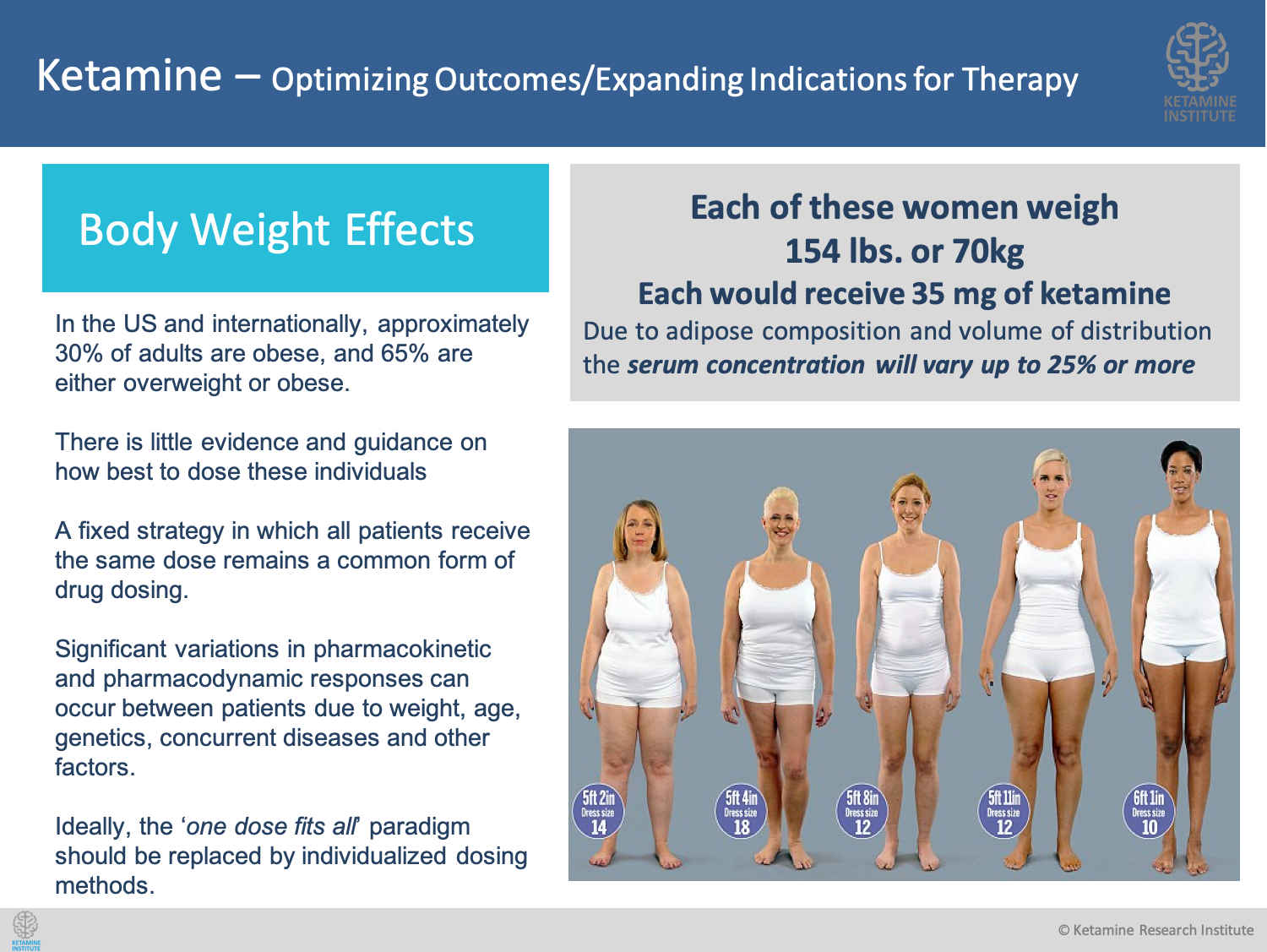
Other medications affect how ketamine works:
Another critical issue is the interaction between common medications and ketamine. Many are unaware that drugs such as Vyvanse, Adderall, Chantix, or Lamictal can significantly impact how ketamine works. Lamictal, for example, has been reported to block the effect of ketamine entirely, and we do not advise patients on that medication to have infusions for that reason.
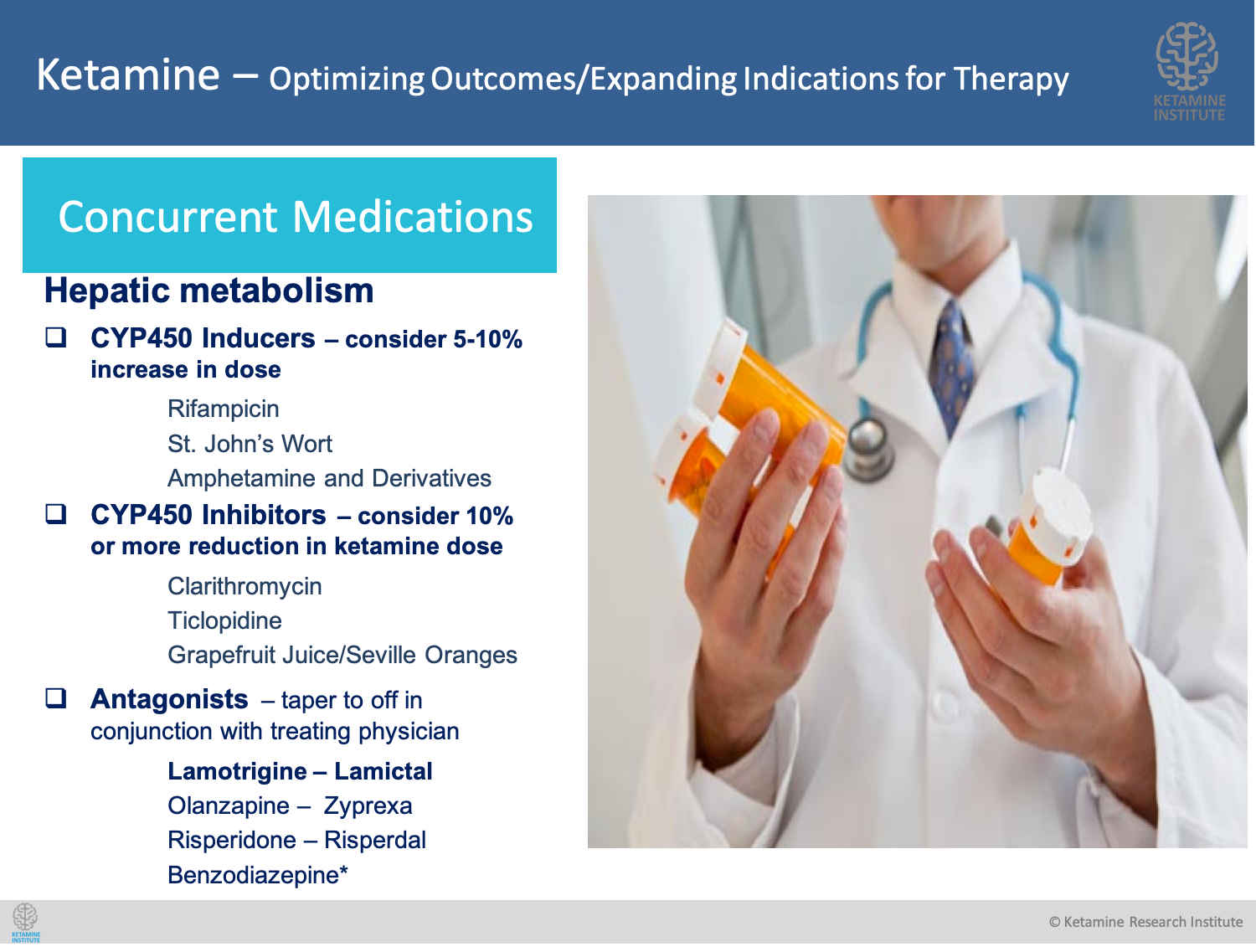
Metabolic and Genetic issues can alter ketamine processing:
Also, very important to understand the effect of your metabolic profile and genetic makeup on the actions of ketamine. We have found that individuals with low testosterone or carnitine levels may not respond optimally, and the infusion may not be as effective. That is one reason why we request blood work before considering someone for an infusion. If these issues are identified and corrected before the infusion, the beneficial results are greatly improved.
The newest approach to effective treatment is called Precision Medicine. We can use specialized genetic testing when necessary and have found that people with a "BDNF variant" or an "MTHFR variant" can have vastly different responses to ketamine. More than that, this type of testing can show individual differences in each individual's capacity to break down medications through what is known as the CYP450 system. Knowing this allows us to provide the best possible dosing strategy to obtain the most excellent chance for improvement.
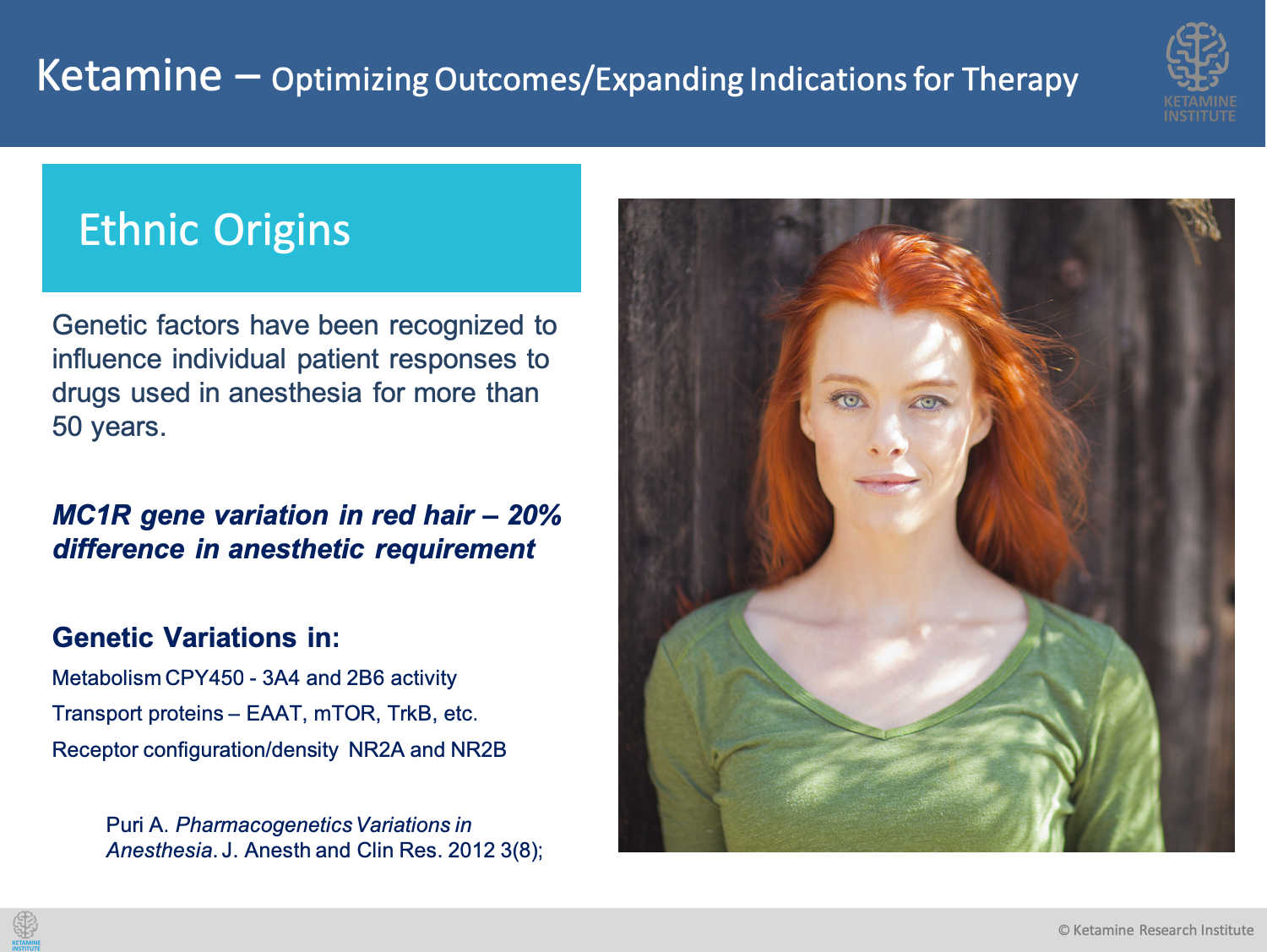
Older Protocol = lower levels of effectiveness:
Lastly, and in many ways, the most crucial reason why the benefits of a ketamine infusion are temporary is due to the old protocol used to administer it and the dose. These factors together often do not allow for or prevent a second, significant step from occurring. For new brain connections to sprout, grow, connect and finally stabilize, you must have a factor to the sustained increase of another vital brain messenger known as "BDNF" or brain-derived neurotrophic factor.

How is RESTORE Different?
The RESTORE infusion also exerts its initial effect by stimulating a glutamate burst, rapidly improving symptoms of depression and anxiety. More importantly, it has a secondary, longer-lasting mechanism of action. We formulate, administer and adjust the infusion for each person's biochemistry and metabolism. Because we tailor the treatment, RESTORE significantly increases the production and release of a critical neurochemical known as "brain-derived neurotrophic factor" or BDNF. BDNF has been compared to a type of "miracle grow" for brain cells. In the presence of this remarkable growth factor — nerves can begin to repair, reconnect and restore previously damaged connections.
The extra supply and release of BDNF promote long-term repair and reconnection of damaged nerve connections that were impaired or lost due to chronic depression and stress. The release of BDNF is accomplished by metabolites that accumulate and continue to act over 5-7 days following the infusion.
The final process involves the "stabilization" of the new connections, which continue to occur over time. The necessary "maintenance" infusions facilitate this process at three months following the first three infusions. The specific intervals for maintenance infusions are vital because they prevent the newly established neural connections from fading or disconnecting again, leading to the return of previous symptoms of depression and anxiety.
Equally important is the RESTORE supplement®, which helps promote and sustain the nerve regeneration properties of the infusion. This provides additional neuromodulators to significantly increase the effectiveness of ketamine. Specific well-known molecules can augment the binding affinity of ketamine for its receptor targets. At the same time, others can enhance the downstream effects of BDNF and mTOR activation, which promote neurogenesis and synaptic plasticity. The addition of these “ketamine-promoters” can unlock the full potential of ketamine’s therapeutic effect.

How we developed the RESTORE Ultra-Rapid Infusion
Now You Know:
So, now you know just a few of the differences between RESTORE and other ketamine infusions. Our clients choose RESTORE because they find it can be faster acting, longer-lasting, and treats more conditions effectively while being less expensive over time than any other ketamine infusion.
That is why RESTORE represents the new "gold standard" in ketamine infusion therapy. We are the only center in the United States that offers the RESTORE Infusions and the Yale-National Institute of Mental Health ketamine infusion, also known as the "standard ketamine infusion."
Now you have choices.
RESTORE is changing the way things are done
The RESTORE Ultra-Rapid Infusion and the RESTORE Essential Infusion are very different from the basic ketamine infusion. We realize that each person is unique, has different needs, experiences and may respond differently to any medication. This must to be taken into account for each person; we know that one size "dose" does not fit everyone.
The RESTORE Infusions are individually tailored to meet your needs and are more effective and can last 3 times longer than other infusions. We have been able to achieve those goals by combining cutting edge research and innovations in the fields of Anesthesiology, Neuropharmacology and Cognition to develop the new RESTORE Infusions.
We understand that living with depression, migraine headache, fibromyalgia or chronic pain can be difficult, but considering a RESTORE Infusion is a step in the right direction. And you’re not alone. RESTORE therapy has been used to treat hundreds of patients all across the country. Learn more about how we can help you today.
Learn how we approach things differently...
Changing the way we approach chronic illness...
RESTORE Advanced Infusion and the RESTORE Essential-PlusPGx Infusion


